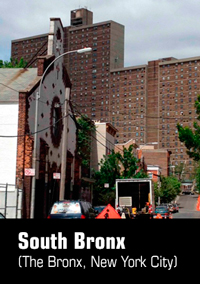 The South Bronx is a socially excluded urban area that has significantly improved over the last 40 years. It has been revitalized and been transformed from a national symbol of urban dystopia into a collection of ordinary working class neighbourhoods. However, stigmatization remains a handicap, environmental problems have not been adequately addressed, housing is still not affordable for many, unemployment is high, the poverty rate remains extreme and access to good education is a serious contemporary problem. In the South Bronx, the Great Recession hit an area that was already vulnerable, shrouded in a sense of a lack of investment. There is a feeling among residents that public authorities have failed their community and they believe that public institutions should do more for the area.
The South Bronx is a socially excluded urban area that has significantly improved over the last 40 years. It has been revitalized and been transformed from a national symbol of urban dystopia into a collection of ordinary working class neighbourhoods. However, stigmatization remains a handicap, environmental problems have not been adequately addressed, housing is still not affordable for many, unemployment is high, the poverty rate remains extreme and access to good education is a serious contemporary problem. In the South Bronx, the Great Recession hit an area that was already vulnerable, shrouded in a sense of a lack of investment. There is a feeling among residents that public authorities have failed their community and they believe that public institutions should do more for the area.
At the same time, though, in recent decades a strong sense of belonging – fostered by the ‘we stay’ movement – has helped build up a community with solid ties and a powerful organizing capacity. This community has struggled, has influenced public policies and has been able to work together with public authorities in order to improve the South Bronx. There is a history in the South Bronx of organizations and interests banding together.
Social innovation is not something new in the South Bronx. The area has been innovative since it was economically devastated in 1970s. Unmet social needs, ineffective public investment and a lack of market interest had created a context where the only way urban problems would be tackled was through community responses that emerged from below. Nonetheless, socially innovative initiatives have been possible because the public sector has played a significant role in funding them and collaborating with them. The model favoured by policymakers has, however, prioritized moderate revitalization in partnership with private companies. Thus, the recognition of the willingness of the South Bronx’s grassroots to struggle is crucial in order to understand why, in some places and at certain times, their transformative approach has been enforced. The community in the South Bronx is still producing effective, socially innovative responses in the contemporary, post-recession environment.